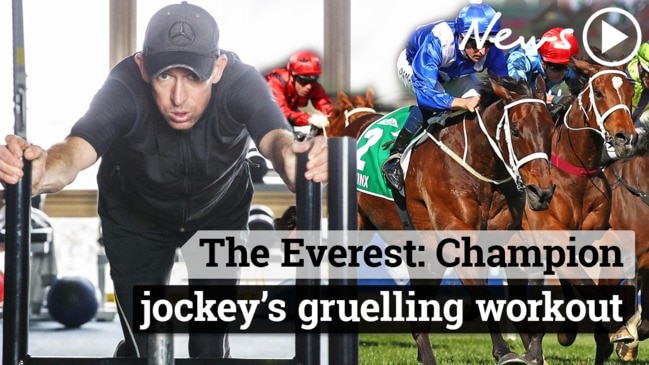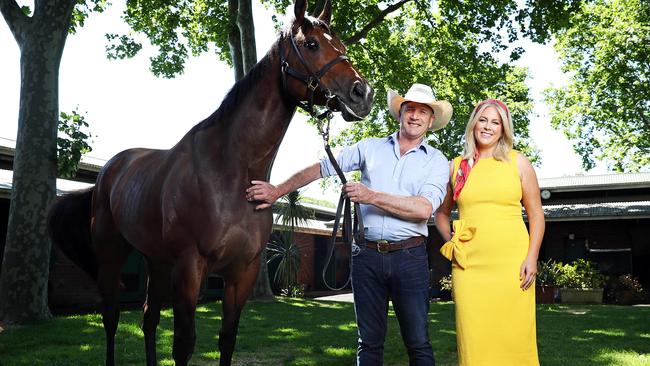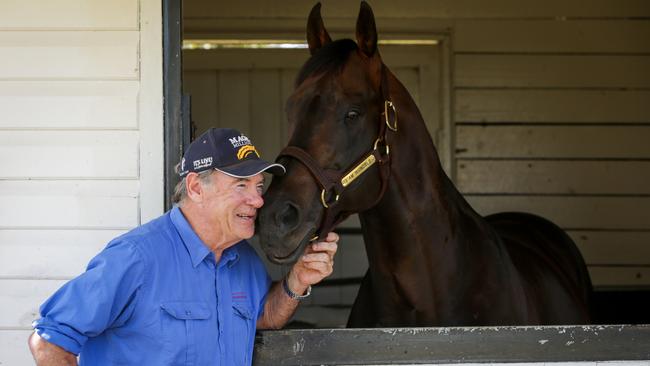Inside the Hunter Valley stud farms producing racing’s elite
The Upper Hunter Valley is the breeding and training ground for some of the fastest and most expensive horses in the world. Take a look behind the gates of Scone’s stud farms ahead of The Everest, the world’s richest race on turf at Royal Randwick tomorrow.

NSW
Don't miss out on the headlines from NSW. Followed categories will be added to My News.
- From princes to paupers, The Everest is a great leveller
- Everest sweep: Beat your mates for bragging rights
- What you get as a subscriber to The Daily Telegraph
IT is racing’s equivalent of The Valley of The Kings – the breeding and training ground of some of the fastest and most expensive horses in the world.
Here gold and bronze statues honouring previous gods of the turf such as Fastnet Rock and Snitzel stand guard over the manicured lawns of the stud farms surrounding Scone in the Upper Hunter Valley.
“This is Australia’s valley of the kings,” Yarraman Park owner Arthur Mitchell said.

It is where they forge champions – leaving the valley’s hoofprint firmly stamped all over The Everest, the world’s richest race on turf, which jumps at 4.15pm at Royal Randwick tomorrow.
“It has become a really important race on the calendar,” Mr Mitchell said. “It is a brilliant concept that has been taken up by the broader public and been a huge success. It will dominate the Caulfield Cup which is run in Melbourne on the same day.”
Yarraman Park’s prize stallion is I Am Invincible, the leading sire in Australia whose progeny Libertini is one of the leading contenders for the big race on Saturday.

Libertini is owned by Harvey Norman’s Gerry Harvey and larrikin mate John Singleton and could provide them with the biggest win in their long career in racing together.
But it is not simply the $15 million in total prize money that is at stake in The Everest – winning can guarantee a horse’s future as a breeding mare or stallion in the valley. It is a stallion making race.
I Am Invincible covers up to four mares a day during the three month breeding season – earning $190,000 for every one that falls pregnant. He has sired foals to champions Black Caviar and Winx, which sadly miscarried this week.
“He came up the hard way,” Mr Mitchell said. I Am Invincible only won $270,000 in prize money on the track and started his career at stud at just $10,000 a pop. But the big, beautifully proportioned stallion produced powerful, fast racehorses and his price went up.
MORE NEWS
20-year-old pleads guilty to planning Sydney terror attack
Channel 10 axes popular reality show
Sam Burgess hits the gym amid legal woes
The opposite of last year’s Everest winner, Yes Yes Yes, which already stands at Coolmore in the valley for $38,500 for every mare that conceives.
“I have been to rugby matches, grand prix, football finals and I have never seen anything as exciting as Yes Yes Yes in The Everest last year,” Coolmore’s principal Tom Magnier said.

Trailing in his wake were two times Everest winner Redzel and contenders from this year’s line up including Nature Strip and Santa Ana Lane.
“It is quite possibly the greatest field of sprinters ever assembled in Australia and he beat them with authority, despite being a spring three-year-old against older horses,” Mr Magnier said.
Yes Yes Yes was retired to stud with a tendon injury after winning The Everest. Coolmore snapped him up because he was a son of resident stallion Rubick.
“He will carry on the great legacy left by his grandsire Encosta De Lago at Coolmore Australia, where he was a multiple Champion Sire,” Mr Magnier said. Encosta De Lago stood for $300,000 a time and his progeny cleaned up $300 million in prize money on the track.
“The Hunter Valley is one of three international centres of thoroughbred excellence in the world, alongside Kentucky in the USA and Newmarket in the UK,” Mr Magnier said.
“There is no one singular ingredient that explains why there have been so many champion racehorses bred in this region, however when you look at a list of horses that have been bred and raised at local farms you know that we are doing something right.”

It is not just one stud that has the valley magic. Darley Stud, the breeding arm of sheik Mohammed bin Rashid Al Maktoum’s Godolphin operation, has bred and trained Bivouac. The colt has earned more than $2 million in prize money before he jumps out of the Godolphin owned slot on Saturday.
Just down the road at Arrowfield the winner of the first two Everests, Redzel, was sired by the legendary stallion Snitzel. This year Arrowfield’s magic is represented by the favourite, Classique Legend, which was sired in the valley by Not A Single Doubt.
Mr Magnier believes it is not just one stud but a combination of all the factors in the valley that has helped it produce the fastest sprinters in the world. “Champions such as Winx have been bred here for hundreds of years and I believe it is a culmination of a multitude of factors that has allowed this to happen.

“The Hunter Valley is home to the best stallions, broodmares and horse men and women in Australasia. It is an industry that has stood the test of time and continued to thrive, and it will do so for many generations to come,” he said.

